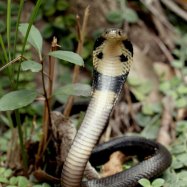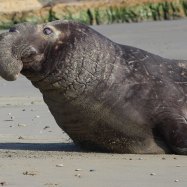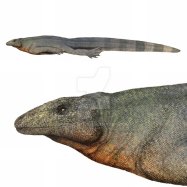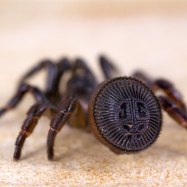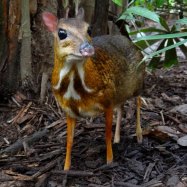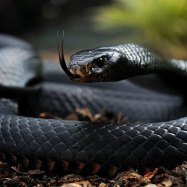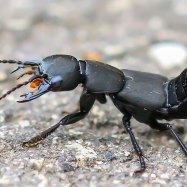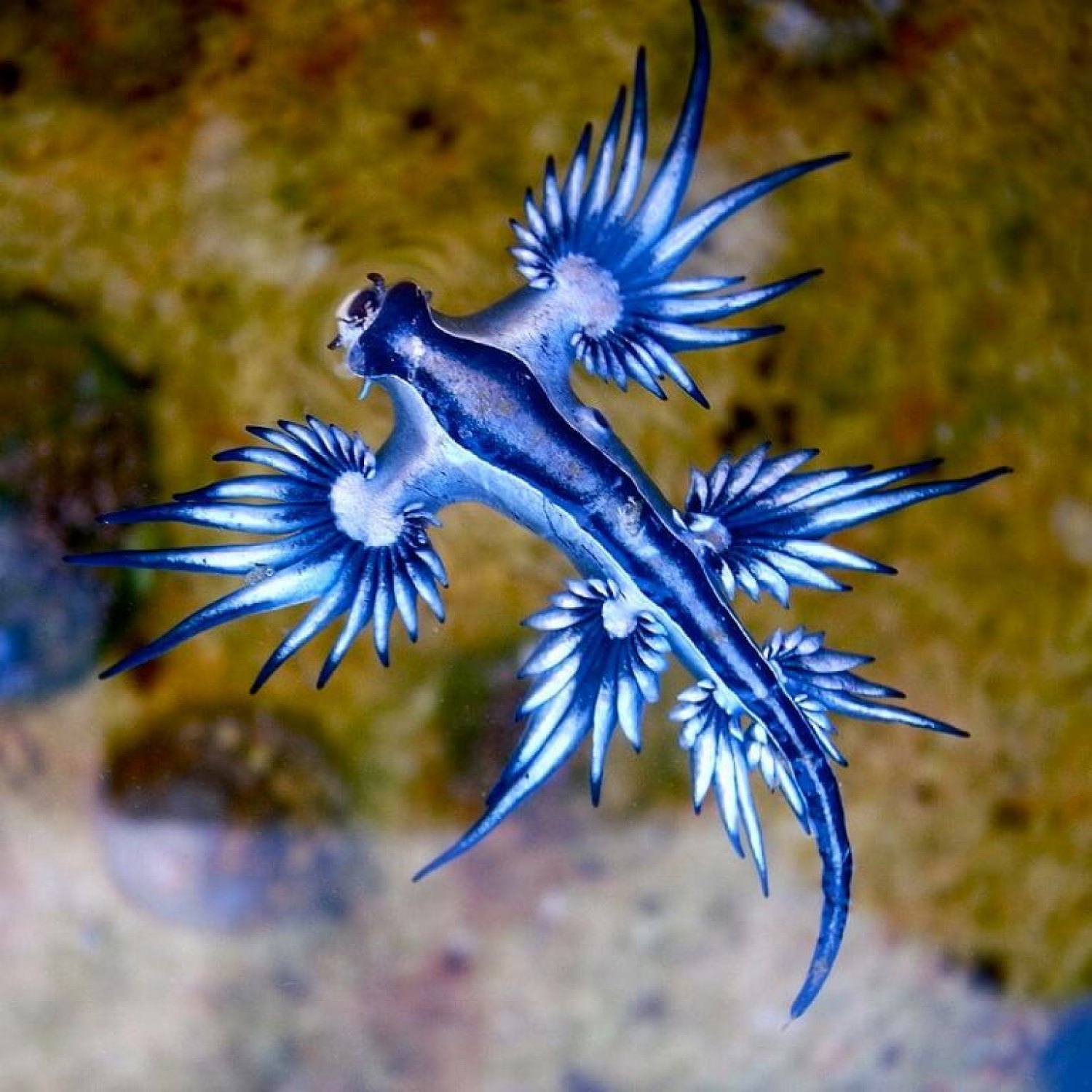
Blue Dragon Sea Slug
Up to 3 cm
Meet the Blue Dragon Sea Slug, a beautiful creature found in coastal areas. With a slender and flattened body, it can grow up to 3 cm in length. Belonging to the family Glaucidae, this tiny, yet mesmerizing animal is a must-see for marine enthusiasts. Keep an eye out next time you visit the beach! #BlueDragonSeaSlug #CoastalCreatures #MarineLife
Animal Details Summary:
Common Name: Blue Dragon Sea Slug
Kingdom: Animalia
Habitat: Marine
The Mystical Blue Dragon Sea Slug: A Marvel of the Marine World
The ocean is home to some of the most fascinating and extraordinary creatures, from giant whales to tiny sea slugs. One such creature that has captured the imagination of marine enthusiasts and scientists alike is the Blue Dragon Sea Slug, scientifically known as Glaucus atlanticus.Also referred to as Blue Angels or Blue Dragons, the Blue Dragon Sea Slug belongs to the kingdom Animalia and phylum Mollusca. They are a part of the Gastropoda class, which includes snails, slugs, and sea hares Blue Dragon Sea Slug. These stunning creatures are classified under the order Nudibranchia and the family Glaucidae.
Found in tropical and temperate oceans worldwide, the Blue Dragon Sea Slug is a true wanderer. They can be found in various coastal areas, making their homes in different countries. Their geographical distribution includes the waters of Australia, South Africa, Brazil, Mozambique, Indonesia, and the eastern coast of the United States, among others.
The Habitat of the Blue Dragon Sea Slug
The marine world is vast and diverse, providing a multitude of habitats for different creatures. The Blue Dragon Sea Slug, too, has adapted to living in a specific type of ecosystem. These creatures are found in the open ocean, floating on the surface of the water.As a pelagic creature, the Blue Dragon Sea Slug spends its entire life at the ocean's surface, floating with the currents. They can also be found in warm, shallow waters, near coastal areas Baiji. Their preferred habitats include regions with a significant presence of their prey, such as cnidarians (jellyfish, anemones, etc.).
Feeding Methods of the Blue Dragon Sea Slug
Being carnivorous, the Blue Dragon Sea Slug's diet consists primarily of other sea creatures. They are specialized hunters, preying on a range of venomous cnidarians, including the Portuguese man o' war and blue bottles. These creatures are known for their ability to feed on animals with powerful stinging cells and incorporate their venom as a defense mechanism.Despite their small size (up to 3 cm), the Blue Dragon Sea Slug is a powerful predator. They use their razor-sharp radula, a teeth-like structure, to scrape and feed on their prey. Their silver stripes also serve as a warning to potential predators, indicating their ability to consume venomous creatures.
The Stunning Appearance of the Blue Dragon Sea Slug
The Blue Dragon Sea Slug is a sight to behold, with its striking blue and silver coloration. These colors serve as camouflage, making them almost invisible to predators when viewed from above and blending in with the ocean's surface.Their slender and flattened body shape also contributes to their camouflage, helping them float seamlessly with the water's surface. Additionally, their body has a wing-like appearance, making them appear like a mythical dragon flying through the water. It's no wonder they have been given the name "Blue Dragon."
While their external appearance is mesmerizing, it's their internal anatomy that truly sets them apart. The Blue Dragon Sea Slug has a unique arrangement of their organs, with their stomach located on the left side of their body and their anus on the right. This adaptation allows them to float and feed efficiently while also providing better protection against predators.
The Biology and Behavior of the Blue Dragon Sea Slug
As with most sea creatures, the Blue Dragon Sea Slug has fascinating biology and behavior. They have a complex reproductive system, with both males and females possessing reproductive organs. They are hermaphrodites, meaning they can produce both eggs and sperm.Their mating process is quite unusual, with the Blue Dragon Sea Slug engaging in a head-to-tail courtship ritual. During this process, they exchange sperm with their partners, and both the individuals can lay eggs. This unique reproductive method contributes to their high reproductive success, ensuring that their species thrives in the wild.
Blue Dragon Sea Slugs are also known for their unusual feeding behavior. Unlike most creatures that feed on their prey and move on, these creatures have been observed holding onto their prey for extended periods. This behavior could be an adaptation to acquire more venom from their prey, making them even more toxic to potential predators.
The Threats Facing the Blue Dragon Sea Slug
Despite their unique and mesmerizing features, the Blue Dragon Sea Slug is facing a multitude of threats. Due to their small size and constant floating behavior, they are often mistaken for debris and mistakenly eaten by larger marine animals.Another major threat to their existence is the pollution of the ocean. As pelagic creatures, the Blue Dragon Sea Slug is at risk of ingesting plastic and other toxic substances, leading to severe health complications. Their small size and abundance also make them easy targets for over-collection by shell collectors, further contributing to their decline.
Conservation Efforts and the Future Outlook for the Blue Dragon Sea Slug
Fortunately, despite the numerous threats facing them, the conservation status of the Blue Dragon Sea Slug is listed as "Least Concern" on the IUCN Red List. However, with climate change and human impacts on the ocean on the rise, it's crucial to continue monitoring these creatures and take necessary conservation measures to ensure their survival.In recent years, conservation efforts have focused on raising awareness about the Blue Dragon Sea Slug and its role in the marine ecosystem. The increase in marine protected areas and anti-pollution campaigns has also contributed to their conservation. And with the rise of citizen science projects, marine enthusiasts and scientists can gather more data on these fascinating creatures and understand their behaviors and needs better.
In conclusion, the Blue Dragon Sea Slug continues to captivate and fascinate those who encounter them. With their unique appearance, complex biology and behavior, and important role in the marine ecosystem, they truly are a marvel of the ocean. As we continue to learn more about these creatures, it's crucial to work towards their conservation and ensure that they continue to thrive for generations to come.

Blue Dragon Sea Slug
Animal Details Blue Dragon Sea Slug - Scientific Name: Glaucus atlanticus
- Category: Animals B
- Scientific Name: Glaucus atlanticus
- Common Name: Blue Dragon Sea Slug
- Kingdom: Animalia
- Phylum: Mollusca
- Class: Gastropoda
- Order: Nudibranchia
- Family: Glaucidae
- Habitat: Marine
- Feeding Method: Carnivorous
- Geographical Distribution: Tropical and temperate oceans worldwide
- Country of Origin: Multiple countries
- Location: Coastal areas
- Animal Coloration: Blue and silver
- Body Shape: Slender and flattened
- Length: Up to 3 cm
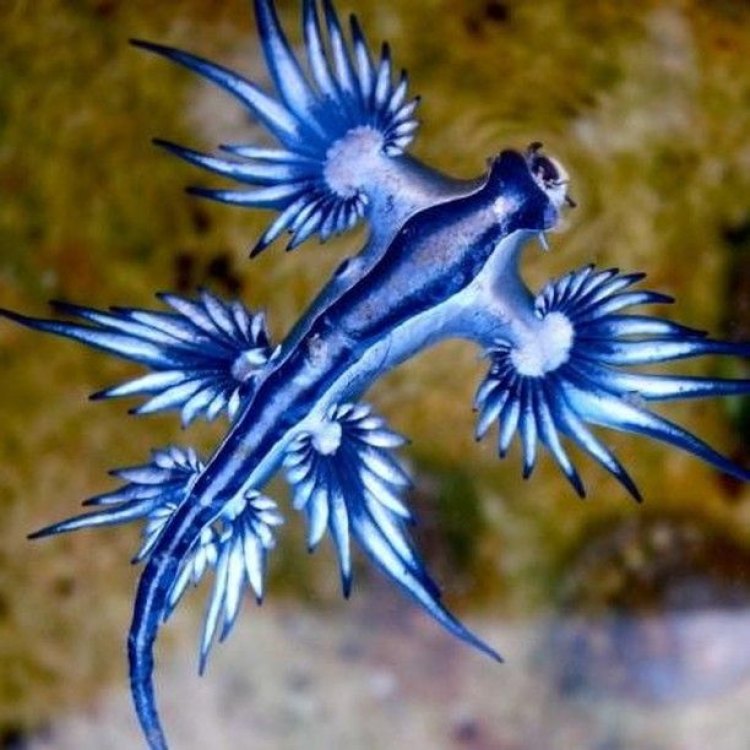
Blue Dragon Sea Slug
- Adult Size: Small
- Average Lifespan: Unknown
- Reproduction: Hermaphroditic
- Reproductive Behavior: Egg laying
- Sound or Call: None
- Migration Pattern: No specific migration pattern
- Social Groups: Solitary
- Behavior: Floats on the surface of the water
- Threats: Predation, habitat destruction, pollution
- Conservation Status: Not evaluated
- Impact on Ecosystem: Preys on other marine organisms
- Human Use: None
- Distinctive Features: Blue coloration with silver undersides
- Interesting Facts: It can consume the venomous Portuguese man o' war and use the venom for its own defense
- Predator: Fish, birds, and other crustaceans
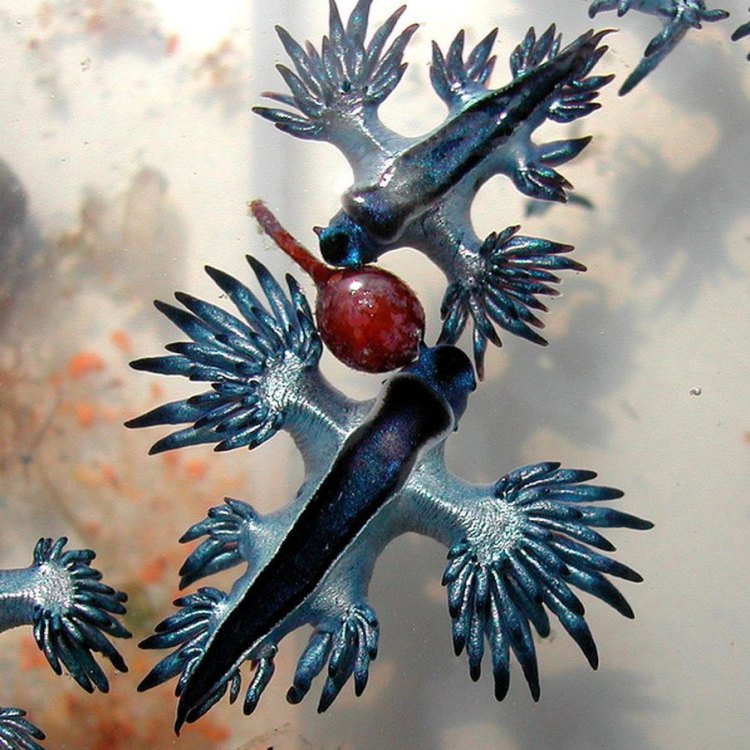
Glaucus atlanticus
The Enigmatic Blue Dragon Sea Slug: A Marvel of Nature
When we think of dragons, we often picture ferocious fire-breathing creatures from fairy tales and folklore. However, in the depths of the ocean, there exists a dragon that defies our imagination and captivates our hearts with its beauty and unique features – the Blue Dragon Sea Slug.The Blue Dragon Sea Slug, also known as Glaucus atlanticus or the “Blue Angel” due to its striking appearance, is a small marine gastropod mollusk that belongs to the family Glaucidae. It can be found in warm and temperate waters around the world, including the Mediterranean Sea, Atlantic Ocean, Indian Ocean, and the Pacific Ocean PeaceOfAnimals.Com.
The adult size of the Blue Dragon Sea Slug is small, averaging around 3cm in length. Its average lifespan, however, remains unknown, as these creatures have not been extensively studied in their natural habitat. But what we do know about these mesmerizing creatures will leave you in awe.
A Unique Reproductive Behavior
One of the most distinctive features of the Blue Dragon Sea Slug is its reproductive behavior. Unlike most sea slugs, which are either male or female, the Blue Dragon is hermaphroditic, having both male and female reproductive organs. This enables them to self-fertilize and produce offspring without the need for a mate.Interestingly, the Blue Dragon Sea Slug lays its eggs in a string-like pattern on the underside of its body, which it then anchors to a floating object, such as seaweed or driftwood. This behavior also gives them their other common name, the “Sea Swallow.”
A Lurking Danger and a Unique Defense Mechanism
Floating on the surface of the water may seem like a relaxing and peaceful activity, but for the Blue Dragon Sea Slug, it can be quite dangerous Banded Krait. Despite its small size, this creature faces numerous threats such as predation, habitat destruction, and pollution.Being at the bottom of the food chain, the Blue Dragon is preyed upon by various marine organisms, including fish, birds, and other crustaceans. However, this sea slug has evolved a unique defense mechanism to protect itself from predators – it feeds on the venomous Portuguese man o’ war.
Similar to its namesake, the Blue Dragon Sea Slug has a voracious appetite and can consume the entire organism, including its venomous tentacles. It then stores these stinging cells in its own body, using them for its own defense when threatened.
A Solitary Lifestyle
Unlike their terrestrial counterparts, the Blue Dragon Sea Slug has a solitary lifestyle, preferring to roam alone in the vast ocean. They are not known to form social groups or exhibit any complex behaviors, except for their reproductive habits.Being solitary creatures, it is difficult for scientists to study the Blue Dragon’s behavior and population size accurately. However, with advancements in technology and an increasing interest in marine biology, more information and research are being conducted on these fascinating creatures.
Distinctive Features: An Undersea Gem
The Blue Dragon Sea Slug’s appearance is undoubtedly its most striking feature. Its body is a dazzling shade of blue with silver undersides, giving it a unique iridescent effect when hit by sunlight. This coloration not only makes them visually appealing but also helps them camouflage in the ocean’s blue hues.Besides its color, the Blue Dragon also has a flattened, wing-like shape, making it look like a miniature version of a mythical dragon. This is also where its other name, the “Blue Angel,” perfectly fits its appearance.
Unknown and Undervalued – The Conservation Status of the Blue Dragon Sea Slug
Despite its striking appearance and unique features, the Blue Dragon Sea Slug’s conservation status is not evaluated. This is due to the lack of data on their population size, habitat, and overall biology.Moreover, with the increasing threats of climate change, habitat destruction, and pollution, the Blue Dragon Sea Slug, like many marine organisms, faces significant risks to their survival. It is crucial to study and preserve these creatures to gain a better understanding of their impact on the ecosystem and our planet’s biodiversity.
The Impact of the Blue Dragon Sea Slug on the Ecosystem
Like most predators, the Blue Dragon Sea Slug plays a crucial role in regulating the marine ecosystem. By preying on other marine organisms, it helps to maintain a healthy balance in the ocean’s food chain.Moreover, the Blue Dragon feeds on the venomous Portuguese man o’ war, which is considered a nuisance to humans. Thus, these sea slugs play a beneficial role in mitigating this issue, making them not just beautiful but also useful to us.
A Final Word – The Human Connection
As humans, our actions often have a direct or indirect impact on the environment and the creatures that call it home. Yet, the Blue Dragon Sea Slug, despite its unique features and importance to the ecosystem, does not have any known human use.This could be seen as a blessing in disguise, as it means they are not exploited by humans for any commercial purposes. However, it is also a reminder of our lack of understanding and appreciation for the incredible creatures that inhabit our planet’s waters.
In conclusion, the Blue Dragon Sea Slug is a marvel of nature, a breathtaking creature with extraordinary features and habits. Its enigmatic behavior, unique reproductive abilities, and distinctive appearance make it a source of fascination and wonder. We must strive to protect and conserve these creatures to keep the ecosystem in balance and preserve the beauty of our planet for generations to come.

The Mystical Blue Dragon Sea Slug: A Marvel of the Marine World
Disclaimer: The content provided is for informational purposes only. We cannot guarantee the accuracy of the information on this page 100%. All information provided here may change without prior notice.

